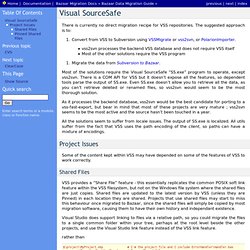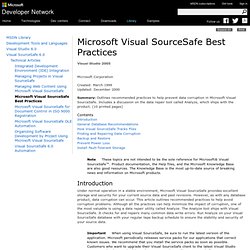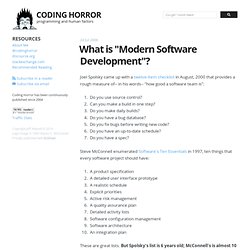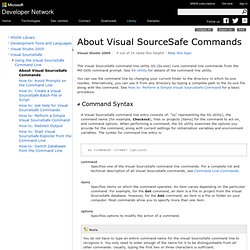

Svn - Sharing the same file between different projects. Sharing Files in SVN. Why do Version Control Systems lack the sharing functionallity of Visual Source Safe and what source control do you use and reckon is worth trying out. Visual SourceSafe — Bazaar Migration Docs. There is currently no direct migration recipe for VSS repositories.

The suggested approach is to: Convert from VSS to Subversion using VSSMigrate or vss2svn, or PolarionImporter. vss2svn processes the backend VSS database and does not require VSS itselfMost of the other solutions require the VSS program Migrate the data from Subversion to Bazaar. Most of the solutions require the Visual SourceSafe “SS.exe” program to operate, except vss2svn. As it processes the backend database, vss2svn would be the best candidate for porting to a vss-fast-export, but bear in mind that most of these projects are very mature ; vss2svn seems to be the most active and the source hasn’t been touched in a year.
All the solutions seem to suffer from locale issues. Some of the content kept within VSS may have depended on some of the features of VSS to work correctly. Shared Files rather than instead $\project\MyProject.vbp # I would link to .. Pinned Shared Files This is a form of branching. Visual SourceSafe Best Practices. Microsoft Corporation Created: March 1999 Updated: December 2000 Summary: Outlines recommended practices to help prevent data corruption in Microsoft Visual SourceSafe.

Includes a discussion on the data repair tool called Analyze, which ships with the product. (10 printed pages) Contents Note These topics are not intended to be the sole reference for Microsoft® Visual SourceSafe™. Introduction Under normal operation in a stable environment, Microsoft Visual SourceSafe provides excellent storage and security for your current source data and past revisions.
Important When using Visual SourceSafe, be sure to run the latest version of the application. General Database Recommendations Database Size Under normal use, your Visual SourceSafe database should not exceed 3 to 5 GB. To reduce potential file size, keep projects that are not interrelated in separate databases. Location Analyze Frequency While running Analyze directly on your production database, you must lock out users.
Free Disk Space. What is "Modern Software Development"? Joel Spolsky came up with a twelve-item checklist in August, 2000 that provides a rough measure of-- in his words-- "how good a software team is": Do you use source control?

Can you make a build in one step? Do you make daily builds? Do you have a bug database? Do you fix bugs before writing new code? Steve McConnell enumerated Software's Ten Essentials in 1997, ten things that every software project should have: A product specificationA detailed user interface prototypeA realistic scheduleExplicit prioritiesActive risk managementA quality assurance planDetailed activity listsSoftware configuration managementSoftware architectureAn integration plan These are great lists. The lists are still highly relevant and definitely worth revisiting today. So here's my question to you: what core set of practices constitutes modern software development in 2006?
How to: Create a C# Test Project. The following sections explain how to create and run the C# code example to automate Visual SourceSafe through the use of the IVSSDatabase interface that represents a Visual SourceSafe database To create a test project in C# do the following: The following example demonstrates how to use the Name property of the IVSSItem interface.

To test the application do the following: Press Control+F5 to build and run your application. The application output:'$/TestFolder' folder name is 'TestFolder. About Visual SourceSafe Commands. A Visual SourceSafe command line entry consists of: "ss" representing the SS utility), the command name (for example, Checkout), files or projects (items) for the command to act on, and command options.

When performing a command, the SS utility examines the options you provide for the command, along with current settings for initialization variables and environment variables. The syntax for command line entry is: ss <command><items> [options] command items Specifies items on which the command operates. Options Specifies options to modify the action of a command. An option is preceded by a hyphen (-), for example, -R. Hg Init: a Mercurial tutorial by Joel Spolsky. Git Reference. Getting and Creating Projects In order to do anything in Git, you have to have a Git repository.

This is where Git stores the data for the snapshots you are saving. There are two main ways to get a Git repository. One way is to simply initialize a new one from an existing directory, such as a new project or a project new to source control. The second way is to clone one from a public Git repository, as you would do if you wanted a copy or wanted to work with someone on a project. Docs book git init initializes a directory as a Git repository To create a repository from an existing directory of files, you can simply run git init in that directory. . $ cd konnichiwa$ ls README hello.rb This is a project where we are writing examples of the "Hello World" program in every language. . $ git init Initialized empty Git repository in /opt/konnichiwa/.git/ Now you can see that there is a .git subdirectory in your project. . $ ls -a . .. .git README hello.rb. Git: Your New Best Friend [Server Side Essentials]
Introduction This article introduces version control and Git without assuming you have any prior knowledge or programming experience.
![Git: Your New Best Friend [Server Side Essentials]](http://cdn.pearltrees.com/s/pic/th/git-your-new-best-friend-13086026)
Because of its introductory nature, certain details are simplified or omitted and the use of the Git Graphical User Interface (Git GUI) is emphasized. Afterwards the reader should be able to use Git for basic version control and know where to locate further information. Version control is the process of recording the history of changes to files as they are modified. Users can go back in time and get old versions and identify where changes were introduced (people sometimes refer to version control tools as time machines).
The first version control (VC) tool, SCCS, was written in 1972 and since that time there have been major advances in the way VC tools are used. Other well-known VC tools – for example Subversion – are classed as centralized and provide only a single place, the repository, into which users store their changes on a regular basis. Concepts <!